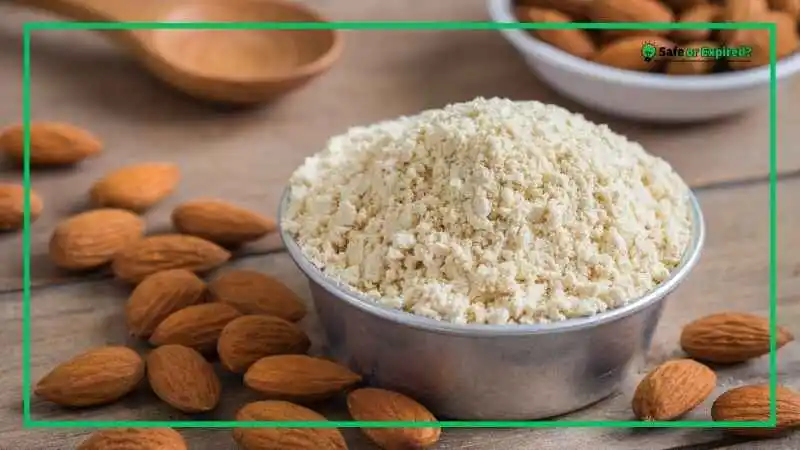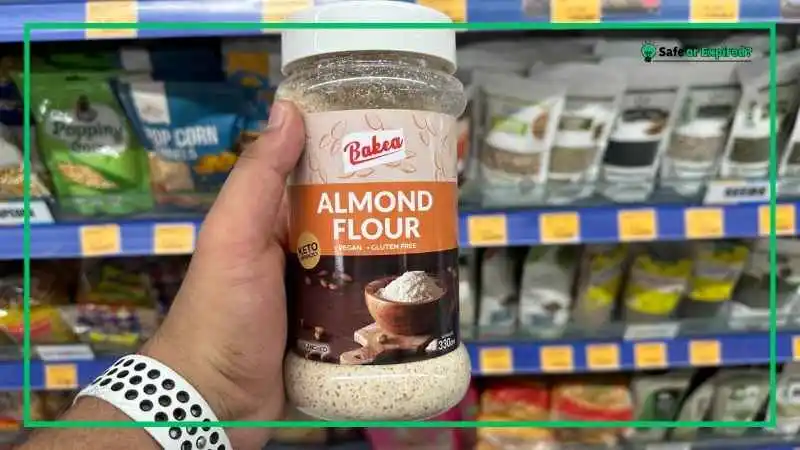“Does almond flour go bad?” is a typical topic in nutrition classes. Yes, Almond flour can spoil if not stored properly. But worry not. In this article, you’ll learn how to tell if it’s gone bad and find creative ways to use it even after it’s expired.
Stay with me to make the most of your almond flour!
Does Almond Flour Go Bad?
Yes, almond flour can go bad. Its shelf life typically ranges from a few months up to a year, depending on whether it’s stored in a pantry, refrigerator, or freezer. As a natural product containing oils, almond flour can degrade over time, particularly in warm or humid conditions.
Moreover, you should consume almond flour within the expiration or best-by date. You can see this on the bottle or label.

Does Almond Flour Go Bad in the Fridge?
Storing almond flour in the fridge can extend its shelf life. When kept in an airtight container, almond flour can last up to six months in the fridge. The cool temperature slows down oxidation, preventing the oils in the flour from turning rancid quickly.
Does Almond Flour Go Bad in the Freezer?
Freezing almond flour is the best way to extend its shelf life. In the freezer, almond flour can last up to one year. Ensure it is stored in an airtight, moisture-proof container to prevent any freezer burn and moisture absorption, which can degrade the quality of the flour.
Does Almond Flour Go Bad on the Counter?
Almond flour has a shorter shelf life when stored at room temperature. On the counter, it can last for about one to two months. The warm temperature can cause the oils to go rancid faster. Always keep it in an airtight container to protect it from air and moisture.
Does Almond Flour Go Bad After Opening?

Once opened, almond flour is more susceptible to going bad due to exposure to air and moisture. If stored properly in a container, it can last up to three months in the pantry, six months in the fridge, and up to a year in the freezer.
To sum up everything, here’s the Almond flour’s shelf life table:
| Storage Condition | Shelf Life (Unopened) | Shelf Life (Opened) |
| Counter | 1-2 months | 1-3 months |
| Fridge | Six months | 6 months |
| Freezer | 12 months | 12 months |
While sorting out how long almond flour lasts, you might be curious about almond extract, too. Why not check out handy tips on how to keep your almond extract fresh for longer?
Does Blanched Almond Flour Go Bad? Know the Answer
Blanched almond flour, made from almonds with their skins removed, can go bad. Like regular almond flour, its longevity depends on the storage conditions. Typically, it can last for several months in the pantry and up to a year if stored in the refrigerator or freezer.
The absence of skins slightly increases its shelf stability.
Does Almond Flour Go Bad After the Expiration Date?
Almond flour can still be used after its expiration date if it has been stored appropriately. However, its quality may begin to deteriorate. It’s important to check the condition of the flour before use. While it may not be harmful after this date, its effectiveness in recipes might be reduced.
But if you have kept almond flour in an airtight jar/container, then you can use it (in most cases).

How To Tell if Almond Flour Has Gone Bad? Crucial Signs
To know if almond flour has gone bad, check for a sour or rancid smell, a change in color, or an off-taste. If it clumps together or shows signs of mold, it’s spoiled. Always trust your senses to determine if it’s still good to use.
Sour or Rancid Smell
One of the easiest ways to tell if almond flour has gone bad is by smelling it. Fresh almond flour has a mild, nutty aroma. What does rancid almond flour smell like? It’s a bit sour. This happens because the oils in the almonds have spoiled.
Imagine sniffing a bag of fresh almonds; that’s how almond flour should smell. If it smells weird or unpleasant, it’s time to throw it away. Trust your nose – it knows when something isn’t right!
Change in Color
Almond flour usually has a light, creamy color. When it goes bad, the color can change to a darker shade. It might look more yellow or brown. This color change happens because the oils in the flour are starting to spoil. If your almond flour looks darker than usual, it’s a sign that it might not be good anymore.
Always compare it to fresh almond flour if you’re unsure. Remember, it’s better to be safe and avoid using it if it looks off.
Off Taste
Tasting a small amount can also help you determine if almond flour has gone bad. Fresh almond flour should taste slightly sweet and nutty. If it tastes bitter or has a strange aftertaste, it has probably gone bad. This bitter taste comes from the spoiling of oils in the almonds.
Just take a tiny bit to taste – you don’t need a lot to tell. If it doesn’t taste right, don’t use it in your cooking or baking.
Clumping Together
When almond flour goes bad, it might start to clump together. Fresh almond flour is light and fluffy. But when it spoils, moisture can cause it to form lumps. These lumps mean that the flour has been exposed to air or moisture, which can make it spoil faster.
If you see clumps in your almond flour, it’s a good idea to check for other signs of spoilage, too. Keep it stored properly to avoid this.
Signs of Mold
Mold is a definite sign that almond flour has gone bad. If you see any fuzzy spots or unusual discolorations, it’s mold. Mold can be dangerous to eat, so if you spot any, throw the flour away immediately. Mold usually grows if the flour has been exposed to moisture.
Always keep your almond flour in a dry place to prevent mold from forming. If you see mold, don’t even think about using it. Your health is more important.
What Happens if You Eat Expired Almond Flour?
Eating expired almond flour might not be pleasant. It can taste bitter and have a rancid smell. While it’s not typically dangerous, it can cause stomach discomfort or food poisoning symptoms if it has gone bad.
Stomach Discomfort
One of the main issues you might face after eating expired almond flour is stomach discomfort. The oils in the almond flour can go rancid, and this can cause your stomach to hurt. You might feel nauseous or even experience some cramping.
It’s like eating something that just doesn’t agree with you. Your body reacts because it recognizes that the food isn’t good anymore. Always make sure to check the smell and taste of almond flour before using it to avoid this problem.
Food Poisoning Symptoms
If the almond flour has gone bad and you eat it, you could experience food poisoning symptoms. This could include feeling very sick, vomiting, or having diarrhea. These symptoms happen because the spoiled flour can harbor harmful bacteria or mold.
Your body tries to get rid of these harmful substances as quickly as possible, which makes you feel really sick. It’s not fun at all. To stay safe, always check for mold or any signs that the flour has gone bad before eating.
Bad Taste and Smell
Eating expired almond flour usually means you’ll notice a bad taste and smell. Fresh almond flour has a nice, nutty flavor, but when it goes bad, it can taste bitter and smell rancid. This can ruin whatever you’re cooking or baking.
So, it’s always better to check the flour before you use it, especially if it’s been in your pantry for a while. Trust your senses – if it smells bad, don’t use it.
Potential Allergic Reactions
Although rare, eating expired almond flour could trigger an allergic reaction in some people. When the flour goes bad, its composition changes, which could potentially cause an allergic response.
Symptoms might include itching, swelling, or trouble breathing. If you know you have nut allergies, be especially careful with old almond flour. It’s always better to be safe and use fresh ingredients to avoid any health risks.
Upset Digestion
Another possible issue from eating expired almond flour is upset digestion. This can mean feeling bloated, gassy, or just generally uncomfortable after eating. Spoiled almond flour can disrupt your digestive system because your body is trying to deal with something it recognizes as not good.
Shelf Life Comparison: Almond Flour vs Others
Almond flour has a unique shelf life compared to other flour. While it can last up to one year in the freezer, other flours have different storage needs and durations. For instance, all-purpose flour, coconut flour, whole wheat flour, and rice flour each have their own shelf lives and storage tips.
Understanding these differences helps in making the best use of each type of flour, ensuring freshness and quality in your baking and cooking.
| Type of Flour | Pantry | Fridge | Freezer |
| Almond Flour | 1-2 months | Two years | 12 months |
| All-Purpose Flour | 6-8 months | Six months | One year |
| Coconut Flour | 3-6 months | 6 months | 12 months |
| Whole Wheat Flour | 1-3 months | One year | Six months |
| Rice Flour | 6-8 months | 1 year | One year |
Now, the details.
Almond Flour
Almond flour has a shorter shelf life because of the oils in the nuts. These oils can go rancid quickly, especially if not stored properly.
In the pantry, it lasts about 1-2 months. In the fridge, it can last up to 6 months, and in the freezer, it can stay good for up to a year.
All-Purpose Flour
All-purpose flour has a longer shelf life. You can keep it in the pantry for 6-8 months. In the fridge, it lasts for about a year, and in the freezer, it can last up to 2 years.
This flour is versatile and great for baking cakes, cookies, and bread. Always store it in a cool, dry place to maintain its quality.
Coconut Flour
Does coconut flour go bad, too? Yes. In the pantry, it lasts for about 3-6 months. In the fridge, the coconut flour can stay fresh for up to 6 months, and in the freezer, it can last up to a year.
Coconut flour tends to absorb moisture, so it’s important to keep it in an airtight container. It’s popular in gluten-free and low-carb baking.
Whole Wheat Flour
Whole wheat flour contains more natural oils because it includes the entire wheat kernel. This makes it spoil faster than all-purpose flour. It lasts about 1-3 months in the pantry. In the fridge, it can last up to 6 months, and in the freezer, it can last about a year. This flour is nutritious and adds a hearty flavor to baked goods.
Rice Flour
Rice flour is used in gluten-free baking. It has a good shelf life, lasting about 6-8 months in the pantry. In the fridge, it can last for about a year, and in the freezer, it can stay fresh for up to 2 years.
This flour doesn’t spoil quickly and is great for a variety of recipes.
What To Do with Expired Almond Flour? Easy Tips For You
If your almond flour has expired, don’t throw it away immediately. You can use it for non-food purposes like making a natural body scrub, cleaning scrub, or even gardening as compost. Always ensure it’s not moldy before using it for these purposes.
Make a Natural Body Scrub
One great way to use expired almond flour is to make a natural body scrub. Mix almond flour with a bit of coconut oil and honey. This creates a scrub that gently exfoliates your skin, leaving it smooth and soft.
Just mix it up and use it in the shower. It’s an easy and fun way to give your skin a treat without wasting the flour.
Use as a Cleaning Scrub
Expired almond flour can also be used as a cleaning scrub for your home. Mix the almond flour with some baking soda and a bit of water to create a paste. This scrub works well on sinks, countertops, and even pots and pans. The almond flour provides a gentle abrasive action that helps to remove grime without scratching surfaces.
Add to Your Compost
If you garden, expired almond flour can be a great addition to your compost pile. It’s an organic material that breaks down and adds nutrients to your compost.
Just sprinkle it in and mix it with other compost materials. It helps enrich the soil, making it better for your plants. Remember, it’s best to use almond flour that isn’t moldy. Mold can harm your compost and your plants.
Make Homemade Playdough
Kids love playdough, and you can use expired almond flour to make some at home. Mix almond flour with a bit of water, salt, and food coloring to create a fun, safe, and non-toxic playdough.
It’s a great way to use up the flour and give kids something fun to play with. Plus, it’s easy to clean up and doesn’t leave any stains.
Use as a Face Mask
Another fun use for expired almond flour is making a face mask. Mix the almond flour with some yogurt and honey to create a soothing and moisturizing mask. Apply it to your face and leave it on for about 15 minutes before rinsing off with warm water. This mask can help exfoliate and nourish your skin, leaving it feeling fresh and smooth.
These are just a few ideas for using expired almond flour in creative and useful ways. Remember, always check for mold before using it for any purpose. If it’s moldy, it’s best to throw it away to avoid any health risks. Enjoy finding new ways to make the most of your almond flour!
Conclusion
Understanding how to keep almond flour fresh is essential for your baking needs. Here’s a quick recap of its shelf life:
- Pantry (Unopened): This lasts about 1-2 months if stored in a cool, dry place.
- Fridge (Unopened): Can stay fresh for up to 6 months when kept in an airtight container.
- Freezer (Unopened): Remains good for about 12 months in a sealed, airtight container.
- Pantry (Opened): Should be used within 1-3 months and stored in a cool, dry place.
- Fridge or Freezer (Opened): Keeps well for 6-12 months when stored in an airtight container.
Proper storage helps keep almond flour fresh and usable for longer. Always check for spoilage signs and use these tips to maximize its shelf life. Happy baking!

